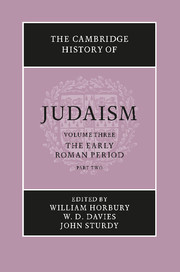Book contents
- Frontmatter
- 1 The archaeology of Palestine 63 bce–ce 70
- 2 The Herodian Temple
- 3 Recent archaeology in Palestine: achievements and future goals
- 4 The contribution of Jewish inscriptions to the study of Judaism
- 5 The social, economic and political history of Palestine 63 bce–ce 70
- 6 The Diaspora in the Roman period before ce 70
- 7 The Gentiles in Judaism 125 bce–ce 66
- 8 Gentiles as seen by Jews after ce 70
- 9 The synagogue
- 10 The Temple and the synagogue
- 11 The early liturgy of the synagogue
- 12 Women in the synagogue
- 13 The Pharisees
- 14 The Sadducees – their history and doctrines
- 15 The Essenes
- 16 The baptist sects
- 17 The troublemakers
- 18 The Samaritans and their sects
- 19 Galilean Judaism and Judaean Judaism
- 20 Jesus: from the Jewish point of view
- 21 Paul: from the Jewish point of view
- 22 Jewish Christianity
- 23 Apocalyptic: the disclosure of heavenly knowledge
- 24 The Qumran sectarian writings
- 25 The Dead Sea Scrolls and pre-Tannaitic Judaism
- 26 Prayer in the Qumran Texts
- 27 Philo of Alexandria
- 28 Josephus (ce 37–c. 100)
- 29 The rabbi in second-century Jewish society
- 30 The Hellenistic–Roman Diaspora ce 70–ce 235: the archaeological evidence
- 31 The legacy of Egypt in Judaism
- 32 Jewish elements in gnosticism and magic c.ce 70–c.ce 270
- Bibliographies
- Index
- References
25 - The Dead Sea Scrolls and pre-Tannaitic Judaism
Published online by Cambridge University Press: 28 March 2008
- Frontmatter
- 1 The archaeology of Palestine 63 bce–ce 70
- 2 The Herodian Temple
- 3 Recent archaeology in Palestine: achievements and future goals
- 4 The contribution of Jewish inscriptions to the study of Judaism
- 5 The social, economic and political history of Palestine 63 bce–ce 70
- 6 The Diaspora in the Roman period before ce 70
- 7 The Gentiles in Judaism 125 bce–ce 66
- 8 Gentiles as seen by Jews after ce 70
- 9 The synagogue
- 10 The Temple and the synagogue
- 11 The early liturgy of the synagogue
- 12 Women in the synagogue
- 13 The Pharisees
- 14 The Sadducees – their history and doctrines
- 15 The Essenes
- 16 The baptist sects
- 17 The troublemakers
- 18 The Samaritans and their sects
- 19 Galilean Judaism and Judaean Judaism
- 20 Jesus: from the Jewish point of view
- 21 Paul: from the Jewish point of view
- 22 Jewish Christianity
- 23 Apocalyptic: the disclosure of heavenly knowledge
- 24 The Qumran sectarian writings
- 25 The Dead Sea Scrolls and pre-Tannaitic Judaism
- 26 Prayer in the Qumran Texts
- 27 Philo of Alexandria
- 28 Josephus (ce 37–c. 100)
- 29 The rabbi in second-century Jewish society
- 30 The Hellenistic–Roman Diaspora ce 70–ce 235: the archaeological evidence
- 31 The legacy of Egypt in Judaism
- 32 Jewish elements in gnosticism and magic c.ce 70–c.ce 270
- Bibliographies
- Index
- References
Summary
The widely held hypothesis that the Dead Sea Scrolls contain the views of Essene sectarians who had hidden them away for safe keeping c.ce 68 was first formulated in the infancy of Qumran studies, when only seven scrolls had been discovered. The identification of the site known as Khirbet (Kh) Qumran as a desert monastery or headquarters of the sect, proposed in the wake of the excavation of the site in the early 1950s, similarly met with widespread scholarly agreement. These two hypotheses have served as basic axioms for most Qumran researchers in their quest for a historical explanation of the manuscripts.
The case in favour of these hypotheses, and consequent historical conclusions, have been put forward in many publications since 1948 (see chapters 15 and 24). The accumulated evidence now pointing, on the contrary, to the Jerusalem origin of the scrolls and their composition by various sects, parties and individuals in pre-Tannaitic Judaism is presented here and the bearing of the scrolls on Judaism in this period is accordingly reconsidered.
THE STATE OF THE MANUSCRIPTS
The term generally applied to Hebrew scripts (square or cursive) employed by copyists of literary texts is ‘Hebrew book hand’, while that given to scripts used to write legal instruments, letters and other autographs is ‘Hebrew documentary hand’. These terms apply not only to the Qumran scrolls, but also to the texts comprising the two other important Hebrew manuscript discoveries of modern times: those of the Bar Kokhba period discovered in Wadi Murabba'at and Nahal geber (second century ce) and those of mediaeval times found in the Synagogue of the Palestinians of Fustat-Misr, known collectively as the Cairo Genizah (primarily ninth to thirteenth centuries).
- Type
- Chapter
- Information
- The Cambridge History of Judaism , pp. 822 - 851Publisher: Cambridge University PressPrint publication year: 1999
References
- 1
- Cited by

